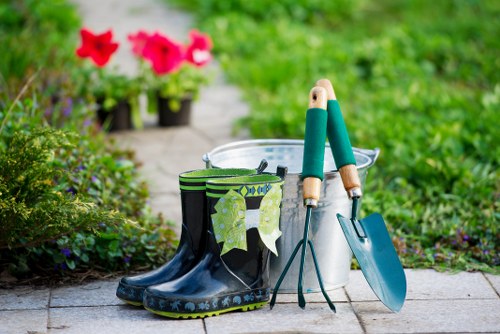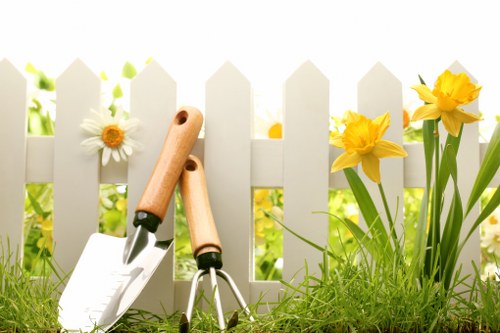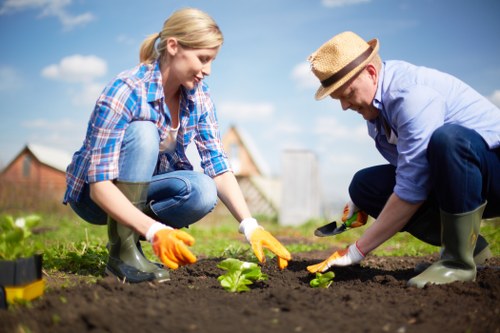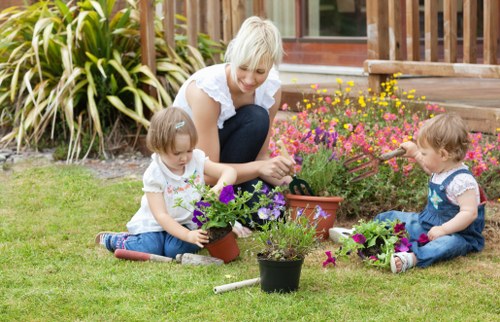Landscape Gardening in Kensington

Landscape gardening in Kensington is an art form that blends aesthetic appeal with functional design, creating outdoor spaces that are both beautiful and practical. Whether you're a seasoned gardener or a novice looking to transform your backyard, understanding the unique aspects of Kensington's environment is key to achieving a thriving garden.
Situated in one of the most vibrant areas, Kensington offers a diverse climate and soil conditions that influence the types of plants and gardening techniques that will flourish. From lush flower beds to structured hedgerows, landscape gardening in Kensington can significantly enhance the curb appeal and value of your property.
In this comprehensive guide, we'll explore the essentials of landscape gardening in Kensington, including design principles, plant selection, sustainable practices, and maintenance tips. By the end, you'll be equipped with the knowledge to create a stunning and sustainable garden that complements the beauty of Kensington.
Understanding Kensington’s Climate and Soil

The first step in successful landscape gardening is understanding the local climate and soil conditions. Kensington experiences a temperate climate with mild winters and warm summers, providing an ideal environment for a wide variety of plants.
Climate Considerations: Kensington's climate supports both deciduous and evergreen plants. The moderate temperatures allow for a long growing season, enabling gardeners to plant a diverse range of flowers, shrubs, and trees.
- Spring: A time of renewal, ideal for planting new shrubs and preparing beds.
- Summer: Perfect for maintaining plants, watering, and enjoying the full bloom of flowers.
- Autumn: Great for planting bulbs and preparing the garden for winter.
- Winter: Focus on planning and protecting plants from frost.
Soil Composition: Kensington's soil varies from sandy to loamy, with areas of clay. Conducting a soil test can help determine pH levels and nutrient content, guiding you in choosing the right amendments to enhance soil fertility.
Design Principles for Kensington Gardens

Effective garden design balances aesthetics with functionality. Here are some key design principles to consider when planning your landscape garden in Kensington:
1. Balance and Symmetry
Creating a sense of balance and symmetry can make your garden appear orderly and harmonious. Symmetrical designs often feature mirrored layouts on either side of a central pathway or focal point.
2. Focal Points
Incorporate focal points such as a striking tree, a water feature, or a sculpture to draw the eye and add interest to your garden.
3. Color Coordination
Choose a color palette that complements the natural surroundings. Harmonious color schemes can enhance the beauty of your garden, while contrasting colors can make specific plants stand out.
4. Texture and Variety
Mixing different textures and plant types adds depth and dimension to your garden. Combine soft foliage with rugged leaves, or tall plants with ground covers to create a dynamic landscape.

Choosing the Right Plants for Kensington
Selecting plants that thrive in Kensington's climate and soil conditions is crucial for a sustainable garden. Here are some recommendations:
- Roses: Known for their beauty and fragrance, roses are a classic choice for any garden.
- Boxwood: Evergreen shrubs that are excellent for hedges and structural elements.
- Lavender: Adds color and attracts pollinators while offering a pleasant scent.
- Hydrangeas: Their large blooms provide vibrant color and texture.
- Hostas: Perfect for shaded areas, offering lush foliage and delicate flowers.
Consider incorporating native plants as they are well-adapted to the local environment, require less maintenance, and support local wildlife.
Perennials: These plants come back year after year, providing long-term color and structure.
Annuals: Ideal for adding seasonal color, annuals can be changed annually to keep the garden fresh and vibrant.

Sustainable Practices in Landscape Gardening
Embracing sustainability in your landscape gardening efforts not only benefits the environment but also enhances the health and longevity of your garden. Here are some sustainable practices to consider:
1. Water Conservation
Implementing efficient watering systems like drip irrigation and soaker hoses can significantly reduce water usage. Additionally, planting drought-resistant species minimizes the need for frequent watering.
2. Composting
Recycling garden waste into compost enriches the soil with essential nutrients, reducing the need for chemical fertilizers and improving soil structure.
3. Organic Pest Control
Using natural pest control methods, such as introducing beneficial insects or using organic sprays, helps maintain a healthy garden ecosystem without harmful chemicals.
4. Mulching
Applying mulch around plants conserves moisture, suppresses weeds, and regulates soil temperature, contributing to overall plant health.
5. Biodiversity
Encouraging a diverse range of plants supports a balanced ecosystem, attracting pollinators and natural predators that help keep pests in check.
By integrating these sustainable practices, your Kensington garden will not only be beautiful but also environmentally friendly.
Hardscaping Elements to Enhance Your Garden
Incorporating hardscaping elements can add structure and utility to your landscape garden. Here are some key features to consider:
1. Pathways and Walkways
Creating defined paths with materials like gravel, stone, or pavers guides visitors through the garden and adds visual interest.
2. Patios and Decks
Designating areas for outdoor seating and dining provides spaces for relaxation and entertainment.
3. Fencing and Boundaries
Fences not only provide privacy and security but can also serve as supports for climbing plants, adding greenery to vertical spaces.
4. Water Features
Integrating elements like fountains, ponds, or waterfalls adds a soothing ambiance and attracts wildlife.
5. Garden Structures
Features such as pergolas, arbors, and trellises offer support for plants and create shaded areas within the garden.
Carefully selecting and placing these hardscaping elements can greatly enhance the functionality and beauty of your Kensington garden.
Seasonal Maintenance Tips
Maintaining your landscape garden throughout the year ensures its health and beauty. Here's a seasonal maintenance guide tailored for Kensington:
Spring
Preparation: Clear any debris from the winter, prune dead branches, and prepare the soil by adding compost.
- Plant new shrubs and perennials.
- Start a regular watering schedule.
- Apply mulch to retain moisture.
Summer
Care: Ensure plants are adequately watered, especially during dry spells. Regularly remove weeds to reduce competition for nutrients.
- Prune overgrown plants to maintain shape and promote airflow.
- Deadhead spent flowers to encourage new blooms.
- Check for pests and treat organically if necessary.
Autumn
Preparation for Winter: Clean up fallen leaves and plant bulbs for spring. Protect sensitive plants from early frost.
- Trim back perennials.
- Harvest any remaining vegetables or fruits.
- Store garden tools and equipment.
Winter
Protection: Focus on planning for the next gardening season. Protect plants from harsh weather conditions and monitor for any winter damage.
- Apply mulch to protect roots.
- Cover delicate plants with frost cloths.
- Plan your garden layout and select plants for the upcoming year.
By adhering to these seasonal maintenance practices, your Kensington landscape garden will remain vibrant and healthy throughout the year.
Incorporating Native and Drought-Resistant Plants
Selecting native and drought-resistant plants is a smart strategy for landscape gardening in Kensington. These plants are well-suited to the local environment, requiring less water and maintenance.
Benefits of Native Plants
Native plants offer several advantages:
- Adaptability: They are naturally adapted to Kensington’s climate and soil, making them more resilient.
- Biodiversity: Native flora supports local wildlife, including pollinators and beneficial insects.
- Low Maintenance: These plants typically require less water and are less susceptible to pests and diseases.
Drought-Resistant Varieties
Incorporating drought-resistant plants can help conserve water and ensure garden sustainability during dry periods.
- Succulents: Plants like sedum and sempervivum store water in their leaves, thriving in arid conditions.
- Lavender: Not only drought-tolerant but also adds fragrance and attracts pollinators.
- Agave: With their striking appearance, agaves are perfect for adding architectural interest.
- Yucca: These hardy plants can withstand prolonged dry spells and add texture to the garden.
By blending native and drought-resistant plants, you can create a sustainable garden that requires minimal intervention while maintaining visual appeal.
Enhancing Your Garden with Sustainable Irrigation
Efficient irrigation systems are vital for maintaining a healthy landscape garden, especially in urban settings like Kensington. Sustainable irrigation practices help conserve water and reduce utility costs.
Drip Irrigation
Drip irrigation delivers water directly to the plant roots, minimizing evaporation and runoff. This method ensures that each plant receives the right amount of water, promoting healthy growth.
Rainwater Harvesting
Collecting and storing rainwater for garden use reduces dependency on municipal water sources. Simple rain barrels can be installed to capture runoff from roofs, providing a sustainable water supply.
Smart Irrigation Controllers
Integrating smart controllers with weather sensors can optimize watering schedules based on real-time data, ensuring plants are watered only when necessary.
Mulching
Applying mulch not only conserves moisture but also improves soil health. Organic mulches like wood chips and straw break down over time, enriching the soil with nutrients.
Implementing these sustainable irrigation techniques will contribute to a resilient and eco-friendly garden in Kensington.
Creating Wildlife-Friendly Gardens
Designing a wildlife-friendly garden enhances biodiversity and creates a thriving ecosystem. Incorporating features that attract and support local wildlife can make your Kensington garden a haven for various species.
Attracting Pollinators
Plants that attract bees, butterflies, and other pollinators are essential for a healthy garden. Consider planting:
- Lavender: Its vibrant flowers and scent are irresistible to pollinators.
- Echinacea: Also known as coneflowers, these attract bees and butterflies.
- Salvia: Offers nectar-rich blooms that support pollinator activity.
Providing Habitat
Creating habitats for birds, bats, and beneficial insects helps maintain a balanced ecosystem.
- Birdhouses: Installing birdhouses encourages nesting and provides shelter.
- Water Sources: Small ponds or birdbaths offer drinking and bathing spots.
- Native Shrubs and Trees: Provide food and shelter for various wildlife.
Reducing Pesticide Use
Avoiding chemical pesticides protects beneficial insects and promotes a natural balance. Instead, use organic pest control methods or introduce natural predators to manage pests.
By fostering a wildlife-friendly environment, your garden becomes a vibrant and dynamic space that benefits both plants and animals.
Incorporating Edible Landscapes
Edible landscaping combines beauty with functionality, allowing you to enjoy fresh produce while enhancing the aesthetic appeal of your garden.
Selecting Edible Plants
Choose plants that are both attractive and productive:
- Herbs: Basil, rosemary, and thyme add flavor to dishes and fragrance to the garden.
- Fruit Trees: Apple, pear, and cherry trees provide delicious fruits and beautiful blossoms.
- Vegetables: Tomatoes, peppers, and lettuce can be grown in designated beds or containers.
- Berries: Strawberries, blueberries, and raspberries offer sweet treats and vibrant colors.
Design Strategies
Integrate edible plants seamlessly into your garden design:
- Garden Beds: Allocate specific areas for vegetables and herbs, ensuring they receive adequate sunlight.
- Vertical Gardening: Utilize trellises and vertical structures for climbing plants like cucumbers and beans.
- Container Gardening: Perfect for limited spaces, containers can hold a variety of edible plants.
Maintenance
Edible plants require regular care to thrive:
- Consistent watering and fertilization.
- Pruning and harvesting to encourage growth.
- Pest management using organic methods.
By incorporating edible landscapes, you not only beautify your garden but also enjoy the rewards of your gardening efforts.
Utilizing Garden Technology
Modern gardening technology can streamline maintenance and enhance the efficiency of your landscape garden.
- Smart Irrigation Systems: Automate watering schedules based on weather conditions and soil moisture levels.
- Garden Sensors: Monitor environmental factors like temperature, humidity, and light to optimize plant care.
- Automated Lighting: Enhance garden aesthetics and security with programmable lighting systems.
- Robotic Lawn Mowers: Maintain your lawn effortlessly with automated mowing solutions.
Incorporating these technologies can save time, reduce resource consumption, and ensure your garden remains healthy and vibrant with minimal effort.
Contact us today to learn more about integrating smart technology into your Kensington landscape garden and take the first step towards a modern, efficient, and stunning outdoor space.
Choosing the Right Landscape Gardener in Kensington
Selecting a professional landscape gardener can make a significant difference in the success of your garden project. Here's what to consider when hiring a landscape gardener in Kensington:
1. Experience and Expertise
Look for gardeners with extensive experience in landscape gardening, particularly in Kensington’s unique environment. Their expertise ensures that your garden will be both beautiful and well-suited to local conditions.
2. Portfolio and References
Review the gardener’s portfolio to assess the quality and style of their work. Asking for references can provide insights into their reliability and customer satisfaction.
3. Services Offered
Ensure the gardener offers a comprehensive range of services, including design, planting, maintenance, and sustainable practices, to meet all your gardening needs.
4. Sustainability Practices
Choose professionals who prioritize sustainable and eco-friendly gardening methods. This commitment aligns with creating a garden that is both beautiful and environmentally responsible.
5. Communication and Compatibility
Effective communication is crucial for translating your vision into reality. Select a gardener who listens to your ideas and collaborates with you throughout the project.
By carefully selecting the right landscape gardener, you can ensure that your Kensington garden becomes a stunning and enduring outdoor space.
Maximizing Small Garden Spaces
Even with limited space, you can create a lush and inviting garden in Kensington. Here are some strategies to maximize small garden areas:
1. Vertical Gardening
Utilize vertical space by installing trellises, hanging planters, and vertical garden systems. This approach allows you to grow more plants without taking up valuable ground space.
2. Compact Plant Varieties
Choose dwarf or compact plant varieties that fit well in smaller spaces without overwhelming the area.
3. Multi-Functional Elements
Incorporate elements that serve multiple purposes, such as benches with built-in planters or storage units that double as garden features.
4. Strategic Layout
Plan your garden layout to make the most of available space. Use zoning to separate different areas, such as a dining spot, a relaxation area, and a planting section.
5. Reflective Surfaces
Incorporate mirrors or water features to create an illusion of more space and add visual interest.
By implementing these techniques, you can transform even the smallest garden area into a vibrant and functional outdoor retreat.
Incorporating Lighting for Ambiance and Safety
Proper lighting enhances both the beauty and safety of your landscape garden. Here’s how to effectively incorporate lighting in your Kensington garden:
1. Pathway Lighting
Illuminate pathways to ensure safe navigation at night while adding a decorative element. Options include solar-powered lights, lanterns, and low-voltage LED fixtures.
2. Accent Lighting
Highlight specific garden features such as sculptures, water features, or unique plants with accent lighting. Spotlights and floodlights can create dramatic effects and draw attention to focal points.
3. Ambient Lighting
Create a warm and inviting atmosphere with ambient lighting solutions like string lights, fairy lights, or lanterns. These options are perfect for outdoor gatherings and evening relaxation.
4. Security Lighting
Enhance the safety of your garden by installing motion-sensor lights around entrances and dark areas. These lights deter intruders and provide peace of mind.
5. Under-Lighting
Use under-lighting techniques for structures like pergolas, decks, and shrubs to add depth and dimension to your garden’s nighttime appearance.
Thoughtfully planned lighting not only improves the functionality of your garden but also extends its enjoyment into the evening hours.
Book your service now to incorporate professional lighting solutions into your Kensington landscape garden and transform your outdoor space into a magical nighttime haven.
Choosing Outdoor Furniture and Accessories
Outdoor furniture and accessories play a significant role in the comfort and functionality of your landscape garden. Selecting pieces that complement your garden’s design enhances both its aesthetic and utility.
1. Seating Options
Select comfortable and durable seating that fits the style of your garden. Options include benches, lounge chairs, and dining sets made from weather-resistant materials like teak, metal, or resin.
2. Tables and Dining Areas
Create designated areas for meals and gatherings with outdoor tables. Consider materials that withstand the elements, and choose sizes that fit your space without overcrowding.
3. Shade Structures
Incorporate shade solutions such as umbrellas, pergolas, or shade sails to provide relief from the sun and create comfortable outdoor living spaces.
4. Decorative Elements
Add personality to your garden with decorative items like cushions, rugs, and outdoor art. These accents can tie together the overall design and make the space feel inviting.
5. Functional Accessories
Enhance the practicality of your garden with accessories like storage benches, fire pits, and outdoor kitchens. These elements add functionality while maintaining the garden’s aesthetic appeal.
By thoughtfully selecting outdoor furniture and accessories, you can create a garden that is both beautiful and functional, perfect for relaxation and entertaining.
Implementing Green Roofing and Vertical Gardens
Innovative gardening techniques like green roofing and vertical gardens are excellent solutions for maximizing space and promoting sustainability in Kensington.
Green Roofing
Green roofs involve covering the roof with vegetation, which provides insulation, reduces runoff, and enhances the building’s aesthetic appeal. Benefits include:
- Energy Efficiency: Green roofs help regulate building temperatures, reducing heating and cooling costs.
- Stormwater Management: They absorb rainwater, minimizing runoff and reducing the risk of flooding.
- Biodiversity: Green roofs create habitats for various species, contributing to urban biodiversity.
Vertical Gardens
Vertical gardens, also known as living walls, allow you to grow plants upward on structures, making them ideal for small spaces. Advantages include:
- Space Saving: Perfect for balconies, patios, and walls where horizontal space is limited.
- Air Quality: Plants in vertical gardens can improve air quality by filtering pollutants.
- Aesthetic Appeal: They add a lush, vibrant look to urban environments.
Incorporating green roofing and vertical gardens into your landscape design not only enhances the beauty of your garden but also promotes environmental sustainability.
Utilizing Native and Heirloom Plant Varieties
Incorporating native and heirloom plant varieties into your landscape garden in Kensington can add uniqueness and support local ecosystems.
Native Plants
Native plants are adapted to the local environment, requiring less maintenance and resources. Benefits include:
- Ecological Balance: They support local wildlife, including pollinators and beneficial insects.
- Resilience: Native plants are more resistant to local pests and diseases.
- Low Maintenance: They typically require less water and care, making them ideal for sustainable gardens.
Heirloom Varieties
Heirloom plants are traditional varieties that have been passed down through generations. They offer:
- Genetic Diversity: Heirloom plants contribute to biodiversity, which is essential for resilient ecosystems.
- Unique Characteristics: Many heirloom varieties have distinct colors, shapes, and flavors not found in modern cultivars.
- Historical Value: Growing heirloom plants connects gardeners to their heritage and preserves cultural history.
By blending native and heirloom varieties, you can create a garden that is not only beautiful but also ecologically significant and culturally rich.
Integrating Art into Your Garden Design
Artistic elements can elevate the visual appeal of your landscape garden, adding personality and sophistication. Here are ways to integrate art into your Kensington garden:
Sculptures and Statues
Strategically placing sculptures or statues can serve as focal points and conversation pieces. Choose designs that complement your garden’s theme, whether modern, classical, or abstract.
Water Features with Artistic Flair
Water features like fountains and ponds can be designed with artistic elements, such as intricate fountains or mosaic-tiled ponds, adding both sound and visual interest.
Decorative Planters
Unique planters made from materials like ceramic, metal, or reclaimed wood can enhance the aesthetic appeal of your plant arrangements.
Garden Lighting Art
Creative lighting fixtures, such as lanterns, fairy lights, or illuminated sculptures, can transform your garden into a magical nighttime space.
Mosaic Paths and Features
Incorporate mosaic designs into pathways, stepping stones, or garden walls to add color and intricate patterns to your garden's layout.
Integrating art into your garden design enhances its uniqueness and creates a captivating environment that reflects your personal style.
Final Thoughts on Landscape Gardening in Kensington
Landscape gardening in Kensington is a rewarding endeavor that combines creativity, sustainability, and functionality. By understanding the local climate, selecting appropriate plants, and implementing thoughtful design principles, you can create a garden that thrives and enhances your property’s beauty.
Embracing sustainable practices and incorporating native and heirloom varieties not only contributes to a healthier environment but also ensures that your garden remains resilient and vibrant year after year.
Whether you're looking to create a serene retreat, a lively entertainment space, or a lush sanctuary for wildlife, landscape gardening in Kensington offers endless possibilities. Invest time and effort into planning and maintaining your garden, and reap the benefits of a stunning outdoor space that reflects your vision and supports the local ecosystem.
Contact us today to embark on your landscape gardening journey in Kensington. Our expert team is ready to help you design and maintain the garden of your dreams. Book your service now and transform your outdoor space into a beautiful and sustainable haven.

